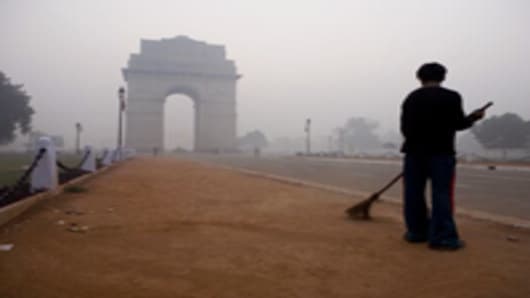India has recently pulled far ahead of China on one dubious development marker — air pollution in the country’s capital.
The air quality in New Delhi on Monday afternoon was significantly worse than the air quality in Beijing, according to real-time air monitors run by the Indian and U.S. governments in both cities.
New Delhi, a landlocked, fast-growing metropolis of more than 16 million people, is regularly shrouded by haze and smog (sometimes euphemistically referred to as fog) in winter months, as barometric pressure and cooler air mix with construction dust, smoke from cow dung fires and car exhaust, which then hover over the city for days.
But this year, the air quality in New Delhi has seemed noticeably worse than previous years as the summer heat dissipates. On Monday, a thick gray haze hung over Delhi’s taller buildings, and a visible film formed quickly on stationary objects, leaving a chemical taste and grime on the skin.
The air feels thick because it is heavy with debris and pollution.
According to a Web site (use the “Air Quality online” link) run by the government of India’s Ministry of Earth Sciences that takes air quality samples hourly from several spots around New Delhi, Air Quality Index, or A.Q.I. measures for the tiniest measures of particulates, known as PM 2.5, were well above 300 on Monday afternoon, a level judged to be “very poor” in India and “hazardous” in other countries.
These particulates, so named because they are 2.5 microns or smaller, are especially dangerous because they can travel deep into the lungs, causing serious respiratory problems. They can be caused by car exhaust, burning coal and chemical plants.
Cooling temperatures are trapping air pollution created by a rising number of cars, which is being supplemented by dusty winds from the northwest, said G. Beig, the program director of the air monitoring program at the Indian Institute of Tropical Meteorology.
The A.Q.I. is an index used to measure various different pollutants which ranges from 0 to 500, with 500 being the highest level of pollution. The U.S. Environmental Protection Agency classifies an overall A.Q.I. over 201 as “very unhealthy” and any A.Q.I. over 301 as “hazardous.” A.Q.I. levels over 301 “would trigger health warnings of emergency conditions,” the E.P.A. says, with the “entire population” likely to be affected.
When related specifically to particulate pollution, the EPA considers any A.Q.I. figure over 151 “unhealthy,” and over 201 as “very unhealthy,” and cautions older people and children should stay indoors, and everyone should avoid heavy exertion.
The A.Q.I. for PM 2.5 at the India Meteorological Department’s headquarters in central Delhi was 320 on Monday afternoon, the Indian Web site said, and the A.Q.I. at the National Center for Medium Range Weather Forecasting in Noida, a Delhi suburb, was 380.
In Beijing, in contrast, the A.Q.I. for these small particulates on Monday was below 200 for much of the day, according to a Twitter feed run by the U.S. Embassy in Beijing, which measures air hourly.
A database recently published by the World Health Organization also shows New Delhi with higher pollution levels than Beijing, but that database relies on official government figures. Beijing’s government has been criticized for down-playing the city’s pollution problems, and recently began tours of its air monitoring facilities.
Delhi’s Pollution Control Board did not immediately respond to calls for comment Monday afternoon.


